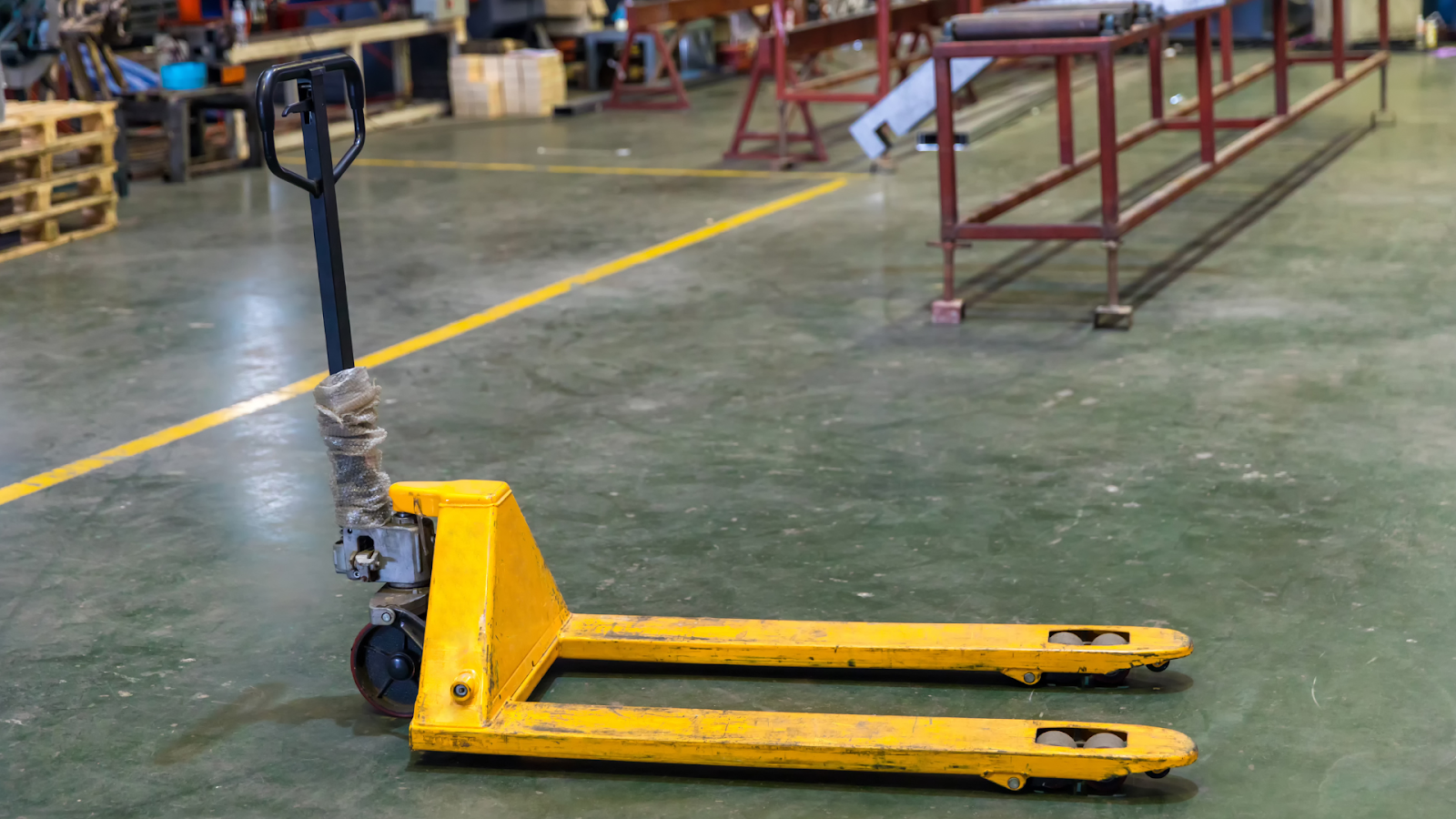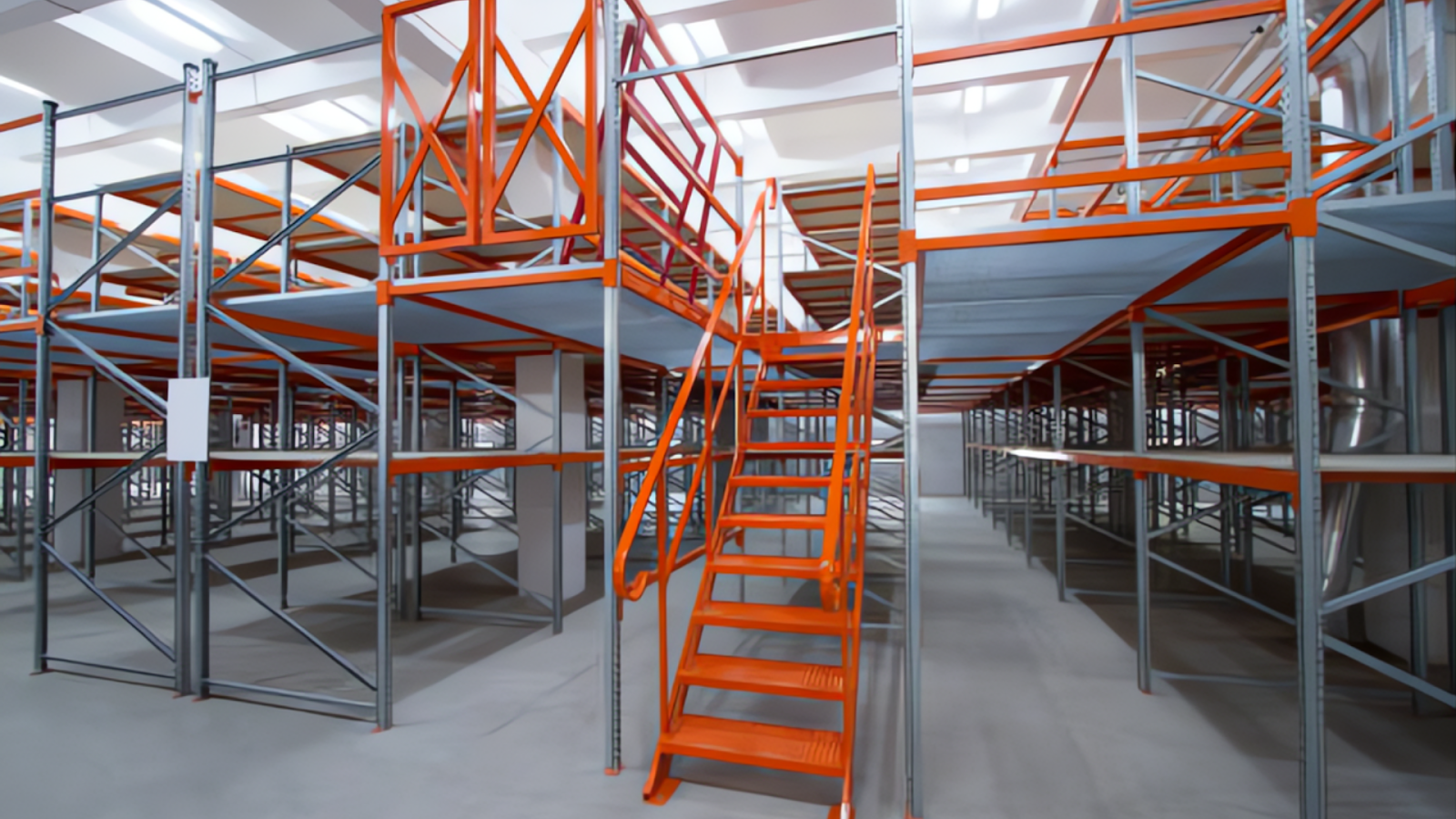Walk through any busy warehouse, and you’ll notice the quiet giants of the operation — rows of steel pallet racks holding tons of inventory overhead. These racks make modern logistics possible, but they also carry serious risk when not installed, maintained, or loaded correctly. One damaged upright or overloaded beam can bring down thousands of pounds of product in seconds.
In the U.S., improperly secured or overloaded pallet racks are among the leading causes of warehouse accidents and product loss. OSHA cites “insecure or unstable stacking and storage systems” under 29 CFR 1910.176(b) as a frequent material-handling violation. Beyond fines and downtime, a rack collapse can injure workers, destroy inventory, and damage equipment — all of which can cost a company hundreds of thousands of dollars.
That’s why pallet rack safety isn’t just an operational guideline; it’s a core part of facility risk management. A safe rack system protects people, products, and profits — creating a workplace that’s not only compliant but resilient.
TL;DR/Key Takeaways
Pallet rack safety refers to the engineering, installation, maintenance, and safe operation of steel storage rack systems used in warehouses and distribution centers. It ensures every rack structure — whether selective, drive-in, or push-back — can support its intended load under everyday working conditions.
Rack safety isn’t owned by one department.
Together, they form the first line of defense against preventable rack failures.
(Also read: How to Anchor Pallet Racks Safely)

Even though there’s no single OSHA standard dedicated solely to pallet racking, several federal and industry-specific regulations govern how these systems must be designed, anchored, and maintained.
This regulation requires all storage systems to be “secured against sliding or collapse” and kept in a safe, stable condition.
Key OSHA expectations include:
The Rack Manufacturers Institute (RMI), accredited by ANSI, defines how racking systems should be engineered, tested, and labeled.
It mandates:
For facilities in seismic zones, racks must comply with the IBC (International Building Code) seismic design provisions. That means additional anchoring, bracing, and sometimes flexible connectors to absorb lateral movement. Regional codes (e.g., California’s CBC) often require engineer-stamped drawings for any new rack installation.
Every rack or bay must display:
Proper signage helps operators instantly recognize limits and prevents guesswork during high-pressure loading.
(For more on system configuration, see Understanding Pallet Racking Dimensions and Sizes).
If your facility hasn’t reviewed its rack layout since installation, it may no longer align with current OSHA or ANSI updates. A brief system review can uncover small compliance gaps before they become costly issues.
[Request a Free Rack Compliance Review]

Most pallet rack failures are preventable. In nearly every case, a small oversight, poor installation, or ignored inspection leads to structural collapse. Understanding the root causes helps warehouse managers identify risks before they become costly incidents.
When racks are not firmly anchored to the floor, even a small shift in load can destabilize the entire structure. Uneven flooring or missing anchors allow movement during forklift operation, creating stress points that worsen with time. The Rack Manufacturers Institute (RMI) requires every upright to be anchored with properly sized bolts embedded into the concrete slab. Always inspect for loose anchors or cracked base plates.
Each rack system is designed to support a specific maximum load. Exceeding that limit, even slightly, weakens beams and uprights over time. Uneven weight distribution also creates imbalances that increase failure risk.
Overloading often occurs when operators:
Clear load signage and regular operator training prevent these mistakes.
(Also read: Understanding Load Capacity in Pallet Racking — and Why It Matters)
Forklift collisions are one of the most frequent causes of rack failure. Even a minor impact can bend an upright or shear an anchor bolt. Once that happens, the structural integrity of the rack is compromised. Installing column guards and end-of-row barriers significantly reduces this risk, especially in high-traffic aisles. Facilities should also ensure adequate aisle width for vehicle clearance and turning radius.
Changing rack configurations without engineering approval can lead to overloading and uneven stress. Adding beams, decking, or extra levels affects load capacity and center of gravity. All structural modifications must be reviewed by a qualified engineer to ensure compliance with ANSI MH16.1 and OSHA stability requirements.
Small issues such as rust, missing bolts, or bent uprights tend to accumulate over time. Without regular inspections, these minor damages become failure points. Warehouse supervisors should maintain a routine inspection checklist and schedule professional audits annually or after any significant impact.
Many warehouses reduce impact damage by combining training with protective gear such as column guards or end-of-row barriers.
Source Equipment’s safety specialists can help identify which protection devices best fit your rack configuration.
[Talk to a Rack Safety Expert]
(Also read: The Complete Guide to Pallet Racking Safety and Maintenance)

Proper rack design and installation form the foundation of safety. A system that meets load and layout requirements will perform reliably for years if installed and maintained correctly.
Anchors must be embedded in a sound concrete slab. The floor should be level, smooth, and capable of bearing concentrated loads. Any cracks or spalling near base plates must be repaired before installation. Double-check anchor torque settings after initial tightening and again after 24 hours to ensure a secure fit.
For guidance, see How to Anchor Pallet Racks Safely.
Aisle dimensions should accommodate the largest material-handling equipment in use. Tight aisles increase collision risks and make load placement difficult. Plan for adequate clearance between rows and near walls, ensuring aisles remain unobstructed. Well-planned layouts improve both safety and efficiency.
Heavier items should always be placed on lower levels. Pallets must rest fully on both beams without overhang or unsupported edges. Consistent pallet dimensions simplify loading and help maintain uniform stress across the structure. Facilities using mixed pallet types should confirm compatibility before storage.
Installing physical guards is a cost-effective way to prevent damage. Common options include:
For high-traffic environments, wire mesh panels or rack netting add an extra layer of security.
(Also read: Guide to Different Types of Pallet Racking)
Every rack should display load limits and system details at eye level. Clear, durable signage ensures operators instantly understand weight restrictions. Labels should include rack manufacturer, model, and load capacity per level and per bay. Replace worn or faded labels immediately.

Even the best-designed pallet racking systems can become unsafe if not regularly inspected. Over time, repeated loading, minor impacts, and environmental wear can compromise the structure. A clear inspection and maintenance plan helps prevent small issues from turning into costly failures.
Warehouse supervisors should perform quick visual checks on a regular schedule, ideally weekly. Look for visible damage, missing safety clips, loose anchors, and bent uprights.
These routine checks allow teams to spot problems early, keeping racks safe between professional audits.
In addition to in-house checks, every facility should schedule a comprehensive inspection by a qualified engineer at least once a year. Inspections should also occur after major impacts, layout changes, or seismic events. A certified inspector can identify less obvious structural weaknesses that daily staff might miss.
All inspection results should be documented with photographs and dates. Keeping a clear record supports OSHA compliance and protects against liability in case of accidents.
A standard checklist typically includes:
Detailed documentation also helps track recurring damage patterns, which can indicate forklift route issues or training gaps.
Regular visual checks are critical, but pairing them with professional audits delivers the best long-term protection.
Source Equipment offers scheduled inspection programs and training resources that help facilities stay audit-ready year-round.
[Set Up a Preventive Inspection Plan]

Modern warehouse operations increasingly rely on technology to enhance rack safety. Digital systems now make it easier to track, analyze, and respond to damage in real time.
Small vibration or impact sensors can be attached to rack uprights. When a forklift or pallet hits the structure, the sensor logs the impact’s location and force. Supervisors receive alerts immediately, allowing them to inspect and isolate affected bays before further use.
These systems are especially useful in large or automated warehouses where impacts can go unnoticed for days.
Mobile inspection apps and IoT dashboards allow managers to log issues, attach photos, and track repair status digitally. Many integrate with warehouse management systems (WMS) to flag bays automatically if they are marked unsafe.
This not only simplifies compliance but also helps prioritize maintenance resources efficiently.
Some large facilities use predictive software to analyze inspection data over time. By identifying patterns, the system predicts which racks are most at risk and recommends proactive maintenance. This approach reduces downtime and eliminates guesswork in scheduling repairs.
Many companies view rack safety as a cost center, but in reality, it’s one of the most cost-effective investments a warehouse can make. The financial and operational returns far outweigh the expense of regular inspections or guard installations.
A single collapsed rack can destroy tens of thousands of dollars' worth of inventory and halt operations for days. Preventive safety measures reduce that risk dramatically. Facilities that conduct consistent inspections report 30 to 50 percent fewer disruptions related to racking incidents.
Regular maintenance prevents corrosion and beam fatigue, extending rack life by several years. This reduces replacement costs and helps companies maximize their capital investment.
Warehouses with documented safety programs often qualify for lower insurance rates. Carriers value consistent inspection records, visible load signage, and clear safety procedures as indicators of reduced risk.
A safe environment builds employee trust. When operators know their racks are structurally sound, they work faster and with greater precision. This has a direct impact on productivity and morale.
A Midwest distribution center suffered a minor rack collapse after years of deferred maintenance. Following a professional audit and installation of column guards, they implemented quarterly inspections. Within a year, the facility reported a 40 percent reduction in rack-related damage and zero safety incidents. The total cost of preventive improvements was less than the cost of the previous single collapse incident.
For more guidance on choosing the right system, see What to Look for When Buying Pallet Racking — and What to Avoid.
Regular inspections are only effective when paired with a clear checklist. Below is a simple compliance guide you can adapt for your facility.
This checklist can serve as a printable safety reference or part of a digital inspection system.
(Also read: A Guide to Industrial Safety Compliance and Best Practices)
For more than three decades, Source Equipment Co., Inc. has been a trusted partner for warehouse operators, manufacturers, and logistics providers across the United States. The company specializes in material handling, warehouse storage, and access equipment, providing tailored solutions that help businesses operate more safely and efficiently.
Source Equipment collaborates with leading manufacturers such as Husky Rack & Wire, Advance Lifts, and Presto Lifts to deliver durable, high-quality systems that meet OSHA and ANSI safety standards. Each product—whether a pallet rack, dock lift, or wire partition—is built for industrial strength and long-term reliability.
Beyond products, Source Equipment offers practical consultation to help businesses maximize space utilization and minimize operational hazards. Their expert team guides customers through everything—from choosing the right pallet rack configuration to planning safe aisle widths and installing impact protection.
If you’re looking to strengthen safety and efficiency across your facility, Source Equipment’s nationwide experts are ready to help.
(Also read: A Behind-the-Scenes Look at How Source Equipment Gets Products from Manufacturer to You)
Next Steps
Every safe warehouse begins with well-designed racks and reliable maintenance.
Source Equipment Co., Inc. works directly with trusted manufacturers to provide U.S. businesses with OSHA-compliant, high-quality storage and handling systems.
Schedule a consultation to get started on improving your warehouse safety today.
Not directly. OSHA’s 29 CFR 1910.176(b) falls under “Material Handling and Storage,” which requires all storage systems to be secured and maintained safely. However, compliance with ANSI/RMI MH16.1 is recognized as the industry benchmark for rack safety.
Perform quick visual checks weekly or monthly, depending on usage. Schedule a professional inspection at least once a year or immediately after any collision, floor repair, or layout change.
Unload the affected bay immediately and mark it as unsafe. Do not attempt temporary repairs. Notify maintenance or a certified engineer for evaluation and replacement parts.
Only under professional supervision. Adding beams, shelves, or higher levels changes the system’s load profile and may require recalculating capacity and new load labels.
Facilities in regions covered by seismic codes (such as California, Washington, or Alaska) must install racks designed and anchored for lateral movement. Consult your engineer or refer to local building codes for seismic design categories.




Ready to Upgrade Your Process Operations?